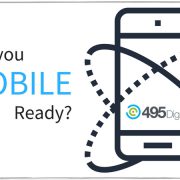Mobile Experience MUST Be A Priority For Brands
/in mobile, web/by 495digitalLet’s face it: The world is going more mobile by the minute. Websites and online stores that used to boast a large percentage of the market share on desktop computers are now struggling to keep up with the boost in mobile usage – a number that is growing every day. Companies must start to prioritize mobile experience now more than ever.
One recent poll showed that 81% of people look at their phones in the hour before they fall asleep, while a whopping 89% of users check their phone within an hour of waking up. The same study showed that half of all smartphone users look at their phone in the middle of the night.
Here’s another statistic that is likely to blow your mind. On average, smartphone users check their phones every 15 minutes throughout the course of the day, around 47 times total. That’s a lot of face time for websites who have taken the step to optimize their site for mobile.
 People are More Dependent on Mobile Than Ever
People are More Dependent on Mobile Than Ever
The problem with many brands who are not prioritizing mobile experience is the steady numbers related to desktop usage. Since those numbers aren’t declining very much, it can be easy to ignore the massive spike in mobile usage. Indeed, what many companies are finding out the hard way is that many customers prefer to perform every step of their shopping. From research, to reviews, to eventual purchase and follow-up, completely on a mobile device.
It’s not just a matter of convenience. 75% of people claim that their smartphones help them to be more productive. 60% of users argue that extensive smartphone usage helps them calm down and feel more prepared to handle day-to-day life. Inevitably, the use of desktop computers will continue to diminish further as mobile technology grows.
What Can Brands Do Now?
If your company isn’t on board with prioritizing a mobile website experience, there’s no time like the present. There are a few very simple things you can do to capture this demographic and the process is quite simple.
- Quick Load Times: Your website should load on a mobile device within (at least) five seconds, or the customer will most likely go somewhere else.
- Connected Experience: Web pages and content should flow from page to page, bringing the customer through a cohesive journey, instead of jilting them around all over the place.
- Quality Links: A click that goes nowhere is a dead link, but it should also be a link that loads quickly too. If people are experiencing long load times every time they try to navigate your site, it’s a conversion killer.
Creating a website that is optimized for mobile will certainly increase your conversion percentage. It will also foster a sense of customer loyalty that helps further purchases from the customer and potential clients. Once people feel like your website can be accessed regardless of platform, they’ll be encouraged to return more frequently. The more your customers return, the more your business can grow.
Contact 495 Digital today to discuss your project.
Engaging Your Alumni With GeoDirect
/0 Comments/in advertising, marketing, mobile/by 495digitalA New Way to Engage Your Alumni
We’ve all received the cold calls, seen the generic emails, and the snail mail with pictures of happy students and a return address for donations.
This has been the extent of alumni engagement for the last 80+ years.
Did it work? Yes.
Does it work today? Nope.
Alumni engagement is the lowest it has ever been, right around 9% in the U.S. Although the situation appears grim, many schools have started evolving their alumni outreach campaign with innovative technology. And they’re reporting resounding success.
One way schools have been able to reach their alumni is through digital canvassing. Through powerful platforms, like GeoDirect, schools can directly reach their graduates through hyper accurate IP targeting using advanced digital canvassing ad technology.
How GeoDirect Works
The process begins by harnessing the power of offline data. GeoDirect is a patented IP targeting software that matches physical addresses with IP addresses, enabling advertisers to deliver their messages with pinpoint precision to the right person, at the exact time of your choosing.
Rather than casting a wide net over a targeted demographic or geographic location, GeoDirect ad campaigns are directly targeted and delivered to predetermined households and audiences — in this case, alumni.
An ad campaign that’s launched under the helm of GeoDirect delivers results that speak (and pay) for themselves.
Why Use GeoDirect? A Case Study

In 2017, we partnered with Gonzaga College High School, an all-boys Catholic school in Washington, D.C.
They were looking for a new, unconventional way to reach their alumni and increase incoming donations.
We worked with Gonzaga to develop an integrated approach to reach graduates and other potential donors during the school’s Annual Fund campaign. After a series of meetings, we helped them develop a new design concept for print advertising, as well as for online display ads that were directed mail recipients in specific households.
Using the addresses Gonzaga provided to us, we put GeoDirect to work. Its targeting system matched all of those physical addresses with IP addresses. So every person who received a piece of traditional mail from Gonzaga was also shown an online ad soliciting donations.
GeoDirect helped make the connection between what alumni received at home in their mailboxes, and the ads they saw on their computers. It’s a proven way to increase campaign engagement and effectiveness. And, for Gonzaga… it worked.
What Other Industries Use GeoDirect?
GeoDirect can be used in virtually any industry that can benefit from more precise and effective marketing and advertising. GeoDirect has been effectively used to enhance results for the following types of organizations.
- Non-Profits & Charities
- Healthcare
- Insurance
- Financial Services
- Hospitality
- Restaurants
- Home Services
- Automotive
- Sports & Events
- Real Estate
- Retail & Consumer Products
- Political
- Legal
- Government Contractors
It’s time to supplement your direct mail campaign! Contact us today to find out how we can put GeoDirect to work for you.
Chatbots: All Hype or Truly Revolutionary?
/0 Comments/in marketing, mobile, social/by 495digitalFacebook has changed the digital marketing world in so many ways. Apart from its robust advertising platform that allows businesses to target their ideal customer base within specific geographic and demographic parameters, one otherwise-overlooked feature is also gaining traction: Facebook Messenger.
Though normally reserved for personal communications, companies have started to develop chatbots to act as virtual assistants, sales personnel, or even just as an extra set of hands to perform tedious tasks. And lest you think this is some kind of marketing gimmick, data suggests that they’re incredibly efficient. JP Morgan Chase, for example, was able to eliminate over 350,000 hours of tedious review time simply by employing bots in their business.
What Are Chatbots?
Simply put, chatbots are automated messaging systems that mimic human conversations through a pre-programmed set of cues and responses. They can be deployed through a medium like Facebook messenger or act as a virtual customer service agent on a website. They’re non-invasive, somewhat-personal, and highly efficient in taking customers through a variety of sales funnels.
Despite their apparent simplicity, chatbots are highly intelligent, taking the information that is given to them by the customer and processing it quickly to move them to the proper department or make appropriate suggestions. They can even provide customer service; If a user has a problem with a product, the chatbot can guide them through a how-to of how to fix the issue at hand.
What Benefits Do Chatbots Offer Businesses?
The benefits to automating various parts of your business is already well-known, but chatbots allow a level of efficiency that makes it a step above.
- Save Money: Though you could hire a developer to create a chatbot for you (which is much less expensive than it used to be), there are also a host of software solutions that can create them for you.
- Automate Processes: Everything that can be automated should in a bid to save time, and chatbots help with that process tremendously. They can handle hundreds of different requests at one time, instead of paying an entire customer service department to do the same thing.
- Room to Grow: One of the best things about chatbots is they don’t overwhelm the user with a myriad of different services, but they also have the potential to do so much more than what they’re currently used for. Once you have them set up and your customers are used to them, you’ll be able to add functionality at will.
What are the Common Types of Chatbots?
There are generally two types of chatbots: simple and complex. Simple chatbots follow a pre-programmed script and very rarely deviate from it, while complex chatbots have the ability to learn from each conversation and develop better responses for future customers. It’s not as sophisticated as some artificial intelligence systems, but it’s far superior to a simple script-based chatbot.
Beyond this, chatbots can also speak to an individual user in a one-on-one conversation or respond to an entire team that is communicating with the chatbots. Moreover, some chatbots are also domain-specific, and can provide a user with unprompted promotional materials or help them navigate the website.
Regardless of what chatbots are used for, there’s no doubting their necessity, both now and in the future. How they’re employed will continue to evolve, but they provide a level of revenue-generating functionality that far surpasses a number of other endeavors.
No One Using Your App? 7 Ways to Bring it Back to Life
/0 Comments/in marketing, mobile/by 495digital
You’ve invested time and money into an app. You and the rest of the team think it’s pretty cool. But two things are jumping out at you: You have zero reviews, and your downloads don’t outnumber your Facebook friends.
It’s time to brush the dust off and get serious about discoverability and engagement. While it’s hard to make a living in the app store, there IS still money to be made. Here are 7 ways to breathe some life into a deadbeat app.
1. Create a User Tutorial
If you want to bring back your first time users, one of the best ways is to create a user walk-through for your app. People need to understand how to use the content that you provide before they will make a purchase. A user walk-through is one of the best ways to introduce yourself to a new audience.
2. Clean Up the User Interface (UI)
If you are not getting the download percentage that you want, you should try to make the interaction with your application easier. Cut down on the number of clicks that people need to perform in order to get something out of your app. Clean up your user interface.
3. Dazzle the Eyes
You can always make your application look better. If given a choice between two apps, all else being equal, the average person will pick the one that catches the eye. Apps are very competitive. Make sure that you have a great-looking user interface and front screen so that you can get all of the traffic that you are supposed to.
4. Give Users Value
Provide real value to the people you are trying to target. One of the best ways to keep you coming back for more and make a purchase is to save them time or money. Entertain them if this is your niche. In some way, you have to make their lives easier, or there is really no reason to come back to your offering. You should also look to provide value that your application users would not have if you were not there.
5. Be OmniPresent
Be a consistent presence in the lives of your target audience. No matter how you choose to engage, consistency is definitely a positive character trait in the marketing and in the design of your application. Get in their heads by getting in their emails. Use push notifications. You can also make use of badge notifications. You can tie in a discount or some sort of a bonus feature announcement when you do this. You actually have many different choices – connect offers in different ways so that people who come to you will not get bored with your consistency.
6. Personalize the App Experience
Look to personalize every single message that you send out into the ether. As the world becomes more digital, the customers in that world demand more personalization. This may seem counterintuitive, but it it is actually exactly how you would expect people to act. As everything becomes colder, personalization is had at more of a premium. If you are the company that provides this to them, then why wouldn’t they come back? They will definitely want to get in touch with you because of your warm countenance and inviting appearance.
7. Hone the Functionality
Lastly, you can always improve the core functionality of your app. You may not be getting the sales that you think you deserve because you have not yet provided the core functionality that your target audience is looking for. Actually, you may have this functionality, but it could be hidden behind a wall of errors. You need to constantly test your application in order to understand what is going on with it. Add new features when the time is right, because your competition will always be catching up to you if you are standing still.
Follow the seven tips above for a higher conversion and retention rate. Applications today are among the most competitive technical products on the market, so you should always look to update your value to the consumer.
Your Customers Are Mobile, So Why Aren’t You?
/0 Comments/in marketing, mobile, web/by 495digitalJust because customers can find your business online using a desktop computer doesn’t mean they can find it using a mobile device. Smartphones and tablets have smaller displays, different operating systems, software and other nuances. Statistics show, however, that 77 percent of U.S. adults own a smartphone, and conversions on mobile devices are 64 percent higher than those on desktop computers.
As a business owner, you can — and should — target these users with a mobile-centric marketing strategy.
Define Mobile Marketing Goals and Objectives
You should first define your mobile marketing goals and objectives. Maybe you want to beat a competitor who’s currently ranking at the top of Google for mobile searches related to your business, or perhaps you want to attract 20 new customers every week.
No two businesses are the same, so it’s important that you create goals and objectives aligned with your business’s needs.
 Develop Mobile-Friendly Web Design
Develop Mobile-Friendly Web Design
Run your business’s website through Google’s mobile-friendly testing tool. If it returns the message “not mobile friendly,” visitors on smartphones and tablets will experience usability problems like content wider than the display, hard-to-read text and two or more links placed too closely together. Not only does this discourage mobile users from interacting with your site, but search engines may lower its ranking as well. Thankfully, a simple solution is to use a responsive web design, which changes your site’s layout automatically to achieve a high level of cross-compatibility on all devices.
Add Your Business to Mobile-Friendly Directories
Your website isn’t the only place where mobile customers can find your business online; they can also find it on web directories. By listing your business on mobile-friendly directories like Yelp, Yellowbook, Whitepages, Superpages.com, Angie’s List and Merchant Circle, you’ll have an easier time reaching mobile customers. Many of these directories also support customer reviews, allowing your business to develop a positive, trustworthy reputation among its audience.
Target Mobile Users With Paid Ads
When advertising your business online, consider paid advertising platforms that support mobile targeting. On AdWords, for example, you can use device targeting for Display Network campaigns, and you use mobile bid adjustments — a feature that automatically bids higher for mobile impressions — for Search Network campaigns. Even Facebook Ads supports device targeting under user behaviors.
Keep in mind that you should only target mobile users with ads after updating your site with a mobile-friendly design.
 Personalize Your Mobile Marketing Efforts
Personalize Your Mobile Marketing Efforts
Many business owners overlook the importance of personalization when promoting their business online. They focus on the technical aspects of digital marketing like measuring click-through rates (CTR) and conversion, forgetting the personal touch that really connects with users. Think about what makes your business unique and memorable, and try to convey that message in your mobile marketing efforts.
Partner With the Right Digital Marketing Agency
Finally, partnering with the right digital marketing agency, like 495 Digital, can maximize your business’s online visibility for mobile users. Unless they work in the digital marketing, most business owners lack the time needed to create and manage mobile marketing campaigns. They toss up a couple of mobile ads, neglecting to monitor and optimize them thereafter. Thankfully, the right digital marketing agency can take this burden off your shoulders, allowing you to focus on your other elements of your business.
Remember: Mobile marketing requires time, resources and patience. With smartphone usage on the rise, however, it can pay off for your business by attracting new customers and establishing your brand as an online authority.
About Us
495 Digital is a strategic branding and cross-channel marketing communications agency. We provide a full range of design, marketing, and advertising services including creative, strategy, content development, campaign implementation, and results reporting.
495 Digital, LLC
1308 Vincent Place
McLean, VA 22101






